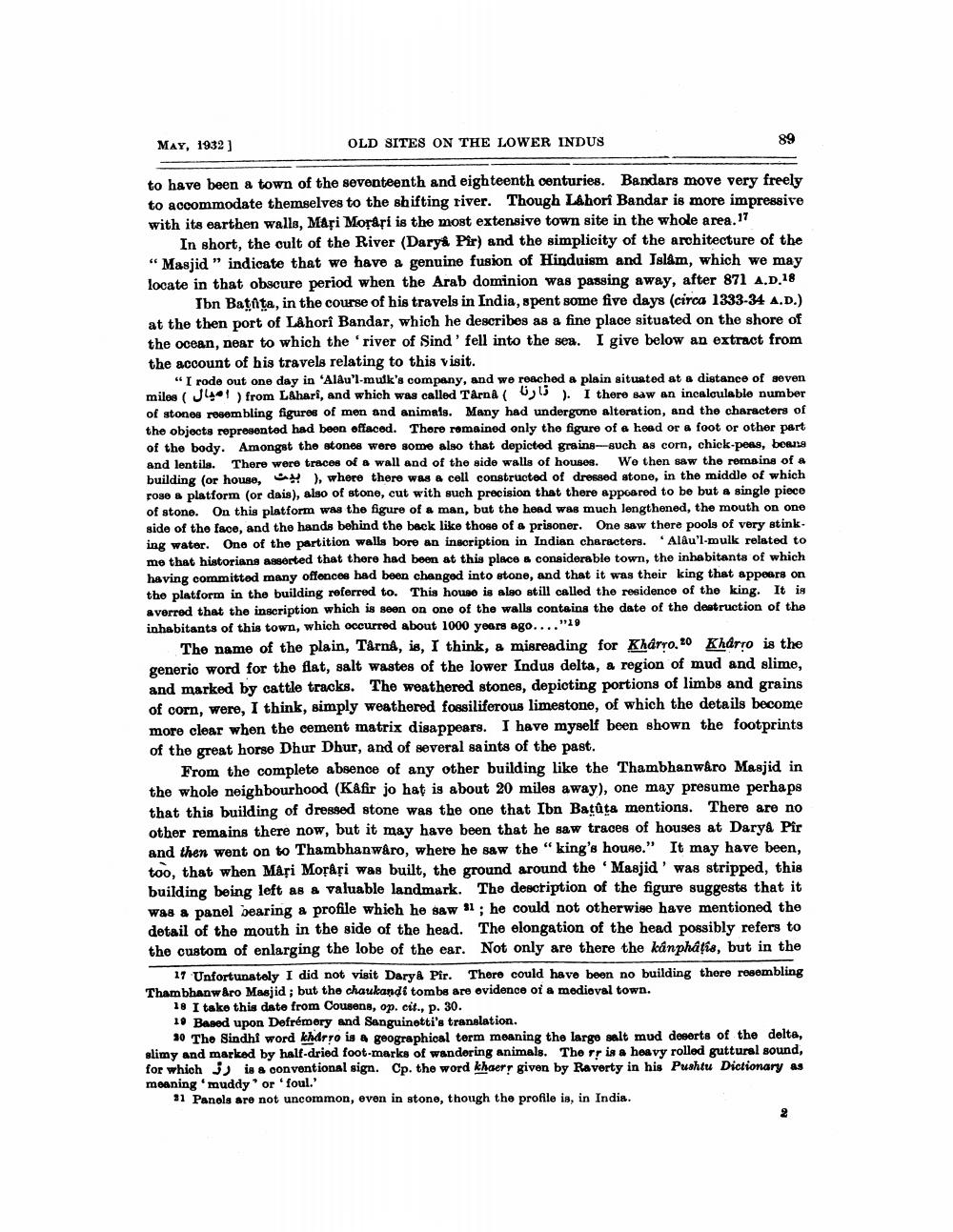________________
MAY, 1932 ]
OLD SITES ON THE LOWER INDUS
89
to have been a town of the seventeenth and eighteenth centuries. Bandars move very freely to accommodate themselves to the shifting river. Though Lahori Bandar is more impressive with its earthen walls, Mași Morari is the most extensive town site in the whole area. 17
In short, the cult of the River (Darya Pir) and the simplicity of the architecture of the “Masjid " indicate that we have a genuine fusion of Hinduism and Islam, which we may locate in that obscure period when the Arab dominion was passing away, after 871 A.D. 18
Ibn Batata, in the course of his travels in India, spent some five days (circa 1333-34 A.D.) at the then port of Lahori Bandar, which he describes as a fine place situated on the shore of the ocean, near to which the 'river of Sind ' fell into the sea. I give below an extract from the account of his travels relating to this visit.
"I rode out one day in Alau'l-mulk's company, and we reached a plain situated at a distance of seven milos (J 1 ) from Lahari, and which was called Tårna ( 0 ). I there saw an incalculable number of stones rosembling figures of men and animals. Many had undergone alteration, and the characters of the objects represented had been offaced. There remained only the figure of a head or a foot or other part of the body. Amongst the stones wore some also that depicted grains-such as corn, chick-peas, boang and lentils. There were traces of a wall and of the side walls of houses. We then saw the remains of a building (or house, S ), where there was a cell constructed of dressed atone, in the middle of which rose & platform (or dais), also of stone, cut with such precision that there appared to be but a single piece of stone. On this platform was the figure of a man, but the head was much lengthened, the mouth on one side of the face, and the hands behind the back like those of a prisoner. One saw there pools of very stink. ing water. One of the partition walls bore an inscription in Indian characters. Alâu'l-mulk related to me that historians asserted that there had been at this place a considerable town, the inhabitants of which having committed many offences had been changed into stone, and that it was their king that appears on the platform in the building referred to. This house is also still called the residence of the king. It is averred that the inscription which is seen on one of the walls contains the date of the destruction of the inhabitants of this town, which occurred about 1000 years ago...."10
The name of the plain, Tårnå, is, I think, & misreading for Kharyo.20 Kharro is the generic word for the flat, salt wastes of the lower Indus delta, a region of mud and slime, and marked by cattle tracks. The weathered stones, depicting portions of limbs and grains of corn, were, I think, simply weathered fossiliferous limestone, of which the details become more clear when the cement matrix disappears. I have myself been shown the footprints of the great horse Dhur Dhur, and of several sa ints of the past.
From the complete absence of any other building like the Thambhanwâro Masjid in the whole neighbourhood (Kafir jo hat is about 20 miles away), one may presume perhaps that this building of dressed stone was the one that Ibn Batâta mentions. There are no other remains there now, but it may have been that he saw traces of houses at Darya Pir and then went on to Thambhanwaro, where he saw the "king's house." It may have been, too, that when Mari Morâți was built, the ground around the 'Masjid' was stripped, this building being left as a valuable landmark. The description of the figure suggests that it W28 a panel bearing a profile which he saw 31; he could not otherwise have mentioned the detail of the mouth in the side of the head. The elongation of the head possibly refers to the custom of enlarging the lobe of the ear. Not only are there the känphâțis, but in the
17 Unfortunately I did not visit Darya Pir. There could have been no building there resembling Thambhanw Aro Masjid ; but the chaukandi tombs are evidence of a medieval town.
18 I take this date from Cousens, op. cit., p. 30. 19 Based upon Defrémery and Sanguinetti's translation.
30 The Sindhi word kharro is a geographical term meaning the largo salt mud deserts of the delta, slimy and marked by half-dried foot-marks of wandering animals. The rr is a hoavy rolled guttural sound, for which is is a conventional sign. Cp. the word khaer, given by Raverty in his Pushtu Dictionary as meaning 'muddy or 'foul.'
31 Panols are not uncommon, even in stone, though the profile is, in India.




